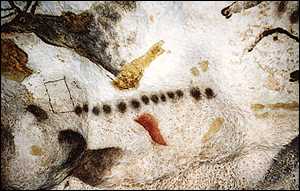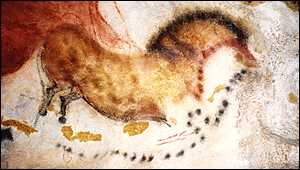
Athabasca University | AU Student/Staff Login | Invited Guest Login
- Blogs
- Colan Mitchell
- Ancient Astronomy
Ancient Astronomy
- Public
15,000 year old lunar calendar at Lascaux Caves, France.
Retrieved from:http://mathildasanthropologyblog.wordpress.com/2008/05/06/15000-year-old-lunar-calendar-at-lascaux-caves-france/ on November 30, 2012
A dappled, brown horse and a lunar calendar
By BBC News Online science editor Dr David Whitehouse in France
What could be the oldest lunar calendar ever created has been identified on the walls of the famous, prehistoric caves at Lascaux in France.
They were aware of all the rhythms of nature. Their survival depended on them
Dr Michael Rappenglueck
The interpretation that symbolic paintings, dating back 15,000 years, show the Moon going through its different phases comes from Dr Michael Rappenglueck, of the University of Munich.
The German researcher has previously associated patterns left in the caves with familiar stars and constellations.
He now says groups of dots and squares painted among representations of bulls, antelope and horses depict the 29-day cycle of the Earth’s satellite.
Works of art
With special permission from French authorities, I went into the Lascaux caves with Dr Rappenglueck to inspect the paintings for myself. It was an opportunity most people would never get – to protect the historic site from unnecessary wear and tear, all visitors now tour a mock-up of the caves, the so-called Lascaux II.
”The secret of understanding these caves,” Dr Rappenglueck told me as we descended into the dark, “is to understand the people who painted these walls.
“They painted the sky, but not all of it. Just the parts that were specially important to them.”
With eyes becoming adjusted to the half-light, I entered the Chamber of the Bulls and stood there in amazement. Anyone who has seen the paintings on the walls can be left in no doubt that they represent some of the greatest works of art every created.
The animals were painted on to the walls of the chamber by Cro-magnon man, one of our close relations, 15,000 years ago. He thrived in a temperate valley in the Dordogne while the rest of Europe was held in the grip of an ice age.
As I marvelled at the spectacle, Dr Rappenglueck moved ahead of me.
“Here it is,” he said, as he headed down the passage. He was pointing to a line of dots painted half way up the wall. “Count them. Count them.”
Below a stunning painting of a deer was a row of 13 dots, ending in a square. “Why 13?” I asked.

Half the cycle: 13 dots and an empty square
“It’s half of the Moon’s monthly cycle,” Dr Rappenglueck said. “One dot for each day the Moon is in the sky. At the new Moon, when it vanishes from the sky, we see an empty square, perhaps symbolically representing the absent Moon.
“But there’s more, further along.” The Munich researcher gestured to me to move along the passageway. Beneath a dappled, brown horse with a dark mane was another row of dots. This time there were more of them.
“There are 29 of them – one for each day of the Moon’s 29-day cycle when it runs through its phases in the sky. It was a rhythm of nature that was important to these people.”
Dr Rappenglueck looked around at the bulls, antelope and horses painted on the walls with such obvious admiration. “They were aware of all the rhythms of nature. Their survival depended on them, they were a part of them.”

The Pleiades star cluster sits above the bull’s shoulder
But there is another puzzle. I pointed to the series of dots that curve away from the main row. “Why do they do that?” I enquired.
“I think that indicates the time of the new Moon, when it disappears from the sky for several days,” said Dr Rappenglueck.
There is definitely astronomy on the walls of Lascaux. Earlier this year, Dr Rappenglueck identified a series of constellations painted on the wall of a shaft off the main chamber at Lascaux. The tiny pattern of the Pleiades star cluster can also be seen hanging above the shoulder of a bull near the entrance to the main passageway.
We will probably never understand completely what Cro-magnon man had in mind when he painted the Lascaux caves. The images of the animals seem obvious but what are we to make of the geometrical shapes and patterns scattered in between these creatures?
Welcome to the Landing
The Landing is a social site for Athabasca University staff, students and invited guests. It is a space where they can share, communicate and connect with anyone or everyone.
Unless you are logged in, you will only be able to see the fraction of posts on the site that have been made public. Right now you are not logged in.
If you have an Athabasca University login ID, use your standard username and password to access this site.
Adding comments to this site
We welcome comments on public posts from members of the public. Please note, however, that all comments made on public posts must be moderated by their owners before they become visible on the site. The owner of the post (and no one else) has to do that.
If you want the full range of features and you have a login ID, log in using the links at the top of the page or at https://landing.athabascau.ca/login (logins are secure and encrypted)
Disclaimer
Posts made here are the responsibility of their owners and may not reflect the views of Athabasca University.




Comments
So neat, whenever i see the words Altamira or Lascaux my curiosity is piqued.